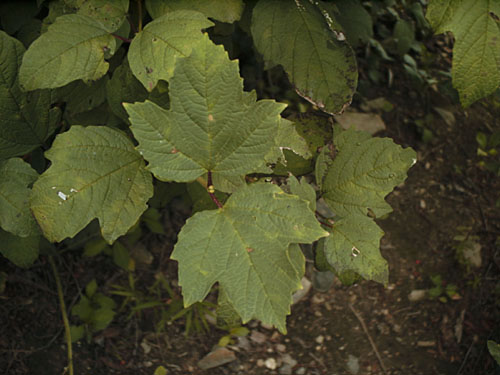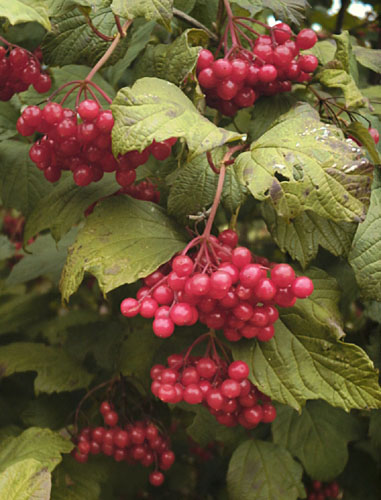Viburnum sargentii
Sargent Viburnum
Caprifoliaceae
ExpandHabitat
- native to northeastern Asia
- hardy to zone 4, and warmer parts of 3
Habit and Form
- a deciduous shrub
- multistemmed, upright form
- 12' to 15' tall
- equal spread
- coarse texture
- moderate growth rate
Summer Foliage
- opposite leaf arrangement
- simple, deciduous leaves
- lobed
- 2" to 5" long
- dark green leaf color
- pubescent underside
Autumn Foliage
- bronze to reddish fall color
Flowers
- white flowers
- clustered in a flat-topped cyme
- 3" to 4" across
- clusters have both sterile and non-sterile flowers
- showy
Fruit
- red fruit
- 0.33" to 0.5' long
- matures in September
- persists
Bark
- tanish-brown stem color
- shiny
Culture
- full sun to partial shade
- easily transplanted and established
- best growth on fertile, moist soils
- very soil adaptable
- soil pH is not critical
- occasional pruning to remove oldest stems may be helpful
- very tough and easy to grow
Landscape Use
- shrub border
- screen
- mass plantings
- small groupings
- useful for flowering and fruiting
- difficult growing sites
Liabilities
- aphids can be particularly problematic
- aphid feeding causes shoots and leaves to twist and contort
- borers occasionally
- needs occasional rejuvenation pruning
ID Features
- opposite, tri-lobed, maple-like leaves
- relatively large, red, fleshy fruits
- ring of sterile flowers surround inner fertile flowers
- flask-shaped buds, 0.33" long
- valvate greenish red color
Propagation
- by cuttings
- by seed
Cultivars/Varieties
var. calvescens - This variant generally grows smaller, to 10' tall, with typical 4" flower clusters and long-lasting red fruit.
'Flavum' - Not commonly available, this selection offers clear yellow fruit. Otherwise, it is like the species.
'Onondaga' - This U.S. National Arboretum introduction is the most popular form of the species in commerce. It is very unique in flower for a Viburnum, as the flat-topped flower clusters feature an outer ring of large sterile, white blooms. Most spectacular, however, is the central mass of small fertile flowers that are dull pink-maroon in color. The contrast between the large white florets and small pink buds/flowers makes for a unique appearance. The young foliage also emerges with a reddish overcast that remains slightly on older foliage. The plant is large and rounded to 8' tall.
'Susquehanna' - Another U.S. National Arboretum cultivar, this plant represents a selection of the species that is most notable for its heavy flower and fruit production. Other features are similar to the straight species.

